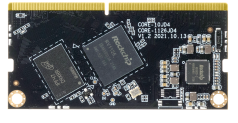7. RTC¶
7.1. Introduction¶
The Core-1109-JD4 development board uses RK808 as the RTC (Real Time Clock). RK809 integrates a crystal oscillator buffer and a real-time clock (RTC). The buffer is used in conjunction with an external 32.768kHz crystal oscillator. With the RTC function, the PMIC can provide seconds/minutes/hours/days/months/years information, alarm wake-up, and time calibration. RK817 provides a 32.768kHz clock with an open-drain output, which is turned on by default and controlled through the I2C interface.
7.2. Driver RTC¶
Driver Reference: kernel/drivers/rtc/rtc-rk808.c
7.3. Interface usage¶
Linux provides three user-space call interfaces. The corresponding path in the Core-1109-JD4 development board is:
SYSFS Interface :
/sys/class/rtc/rtc0/PROCFS Interface :
/proc/driver/rtcIOCTL Interface :
/dev/rtc0
7.3.1. SYSFS Interface¶
You can directly use the interface below cat and echo operations /sys/class/rtc/rtc0/.
For example, check the date and time of the current RTC:
# cat /sys/class/rtc/rtc0/date
2013-01-18
# cat /sys/class/rtc/rtc0/time
09:36:10
Set the startup time, such as starting up after 120 seconds:
#Start the machine regularly after 120 seconds
echo +120 > /sys/class/rtc/rtc0/wakealarm
# View boot time
cat /sys/class/rtc/rtc0/wakealarm
#To turn it off
reboot -p
7.3.2. PROCFS Interface¶
Print RTC related information:
# cat /proc/driver/rtc
rtc_time : 06:53:50
rtc_date : 2022-06-21
alrm_time : 06:55:05
alrm_date : 2022-06-21
alarm_IRQ : yes
alrm_pending : no
update IRQ enabled : no
periodic IRQ enabled : no
periodic IRQ frequency : 1
max user IRQ frequency : 64
24hr : yes
7.3.3. IOCTL Interface¶
You can use ioctl to control /dev/rtc0.
Please refer to the document rtc.txt for detailed instructions.
